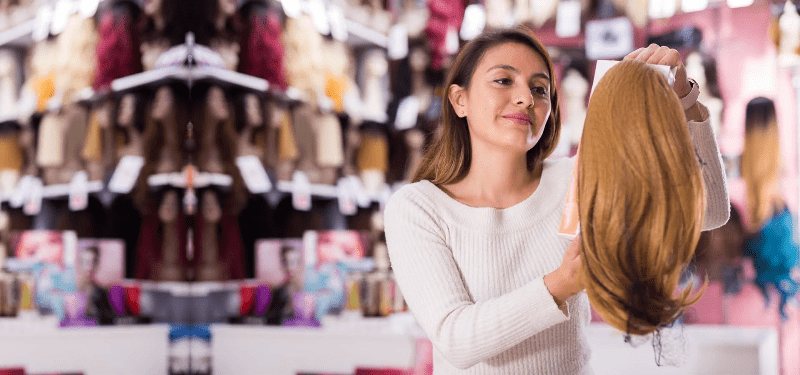Hair wigs have long been a staple in fashion, beauty, and personal care. From their use in ancient civilizations to today’s modern styles, wigs have become more than just a cosmetic accessory—they’re a way to express identity, enhance confidence, and even provide solutions for medical hair loss. Whether you’re new to wigs or looking to expand your collection, understanding the different types, benefits, and styling tips can help you make the most of this versatile accessory.
A Brief History of Hair Wigs
Wigs have been around for thousands of years. Ancient Egyptians wore wigs not only for fashion but also as protection against the sun. In Europe, wigs became symbols of status and authority during the 17th and 18th centuries. Today, wigs are worn for a variety of reasons—fashion, practicality, or medical needs—but they continue to carry that same aura of transformation and empowerment.
Types of Hair Wigs
- Synthetic Wigs
Made from man-made fibers, synthetic wigs are popular for their affordability and low maintenance. They come pre-styled, meaning they hold their shape even after washing. However, they typically don’t last as long as human hair wigs and may not withstand heat styling.
- Human Hair Wigs
Human hair wigs are crafted from real hair, offering the most natural look and feel. They can be styled with heat tools, dyed, and treated like your natural hair. Although they’re more expensive, their versatility and durability make them a preferred choice for many.
- Lace Front Wigs
These wigs have lace material at the front, creating a natural-looking hairline. They’re highly popular among people seeking a realistic appearance, especially for styling hair away from the face.
- Full Lace Wigs
Unlike lace front wigs, full lace wigs have lace throughout the cap, allowing for styling versatility such as updos and ponytails. They are lightweight, breathable, and highly natural but often come with a higher price tag.
- Monofilament Wigs
These wigs feature a special cap where individual hairs are hand-tied, creating the illusion of natural hair growth. They’re an excellent option for people with sensitive scalps.
Why People Wear Wigs
- Fashion and Style
Wigs allow for endless experimentation with hairstyles, lengths, and colors without commitment. You can go from short blonde to long brunette overnight, all without damaging your natural hair.
- Medical Reasons
Hair loss from conditions such as alopecia, chemotherapy treatments, or hormonal imbalances can significantly affect confidence. Wigs provide an empowering solution, helping individuals regain self-esteem.
- Convenience
Maintaining natural hair can be time-consuming. Wigs offer a quick, easy way to achieve a polished look, saving time in daily routines.
- Protective Styling
Wigs protect natural hair from environmental stress, heat, and chemical damage. Many people use wigs as a way to give their natural hair a break while still enjoying stylish looks.
Choosing the Right Wig
When shopping for a wig, consider these factors:
- Purpose: Are you buying it for daily wear, a special occasion, or medical reasons?
- Material: Synthetic wigs are budget-friendly, while human hair wigs offer premium quality.
- Cap Construction: Lace front, full lace, or monofilament caps each offer different levels of realism and comfort.
- Size: Proper fit is essential. Many wigs come in adjustable sizes, but measuring your head ensures the right choice.
- Color and Style: Consider what complements your skin tone, lifestyle, and personal preferences.
Wig Care Tips
To keep your wig looking fresh and lasting longer, follow these care practices:
- Washing: Wash your wig every 6–8 wears, or sooner if there’s product buildup. Use wig-specific shampoos and conditioners.
- Drying: Gently blot excess water with a towel and let the wig air-dry on a stand. Avoid wringing or twisting.
- Styling: For synthetic wigs, avoid heat styling unless labeled “heat-resistant.” For human hair wigs, use heat tools sparingly and always apply protectant.
- Storage: Keep wigs on a stand or in a satin bag when not in use to maintain shape and avoid tangling.
- Brushing: Use wide-tooth combs or wig brushes, starting from the ends and working upward to prevent shedding or damage.
Trends in Hair Wigs
The wig industry has evolved significantly, especially with the influence of celebrities and social media. Some popular trends include:
- Colorful Wigs: Bold hues like pink, blue, and purple are now mainstream.
- Natural Textures: Wigs with curls, coils, and waves that mimic natural hair textures are highly sought after.
- Glueless Wigs: These provide convenience and comfort without adhesives, perfect for daily wearers.
- Custom-Made Wigs: Many buyers now prefer wigs tailored to their head measurements, lifestyle, and style preferences.
Common Misconceptions About Wigs
- “Wigs Look Fake.” Modern wigs, especially lace front and human hair wigs, are nearly indistinguishable from natural hair when applied correctly.
- “They’re Uncomfortable.” Advances in cap construction have made wigs lightweight, breathable, and comfortable for extended wear.
- “Only for Hair Loss.” While wigs help people experiencing hair loss, they’re also widely used for fashion and convenience.
Boosting Confidence Through Wigs
Beyond style and practicality, wigs hold emotional significance. For many individuals, especially those coping with hair loss, wigs are more than accessories—they’re tools for reclaiming confidence and self-expression. Wearing a wig can turn insecurity into empowerment, making the wearer feel radiant and self-assured.
Conclusion
Hair wigs are far more than a fashion statement. They’re a versatile, empowering tool that combines beauty, practicality, and confidence. Whether synthetic or human hair, lace front or full lace, wigs open doors to endless styling possibilities while offering solutions for medical and lifestyle needs.
By choosing the right wig, caring for it properly, and embracing its versatility, you can transform your look and boost your confidence instantly. From ancient times to today’s modern trends, wigs continue to prove that beauty is not just about what grows naturally—it’s about how we choose to express ourselves.



































